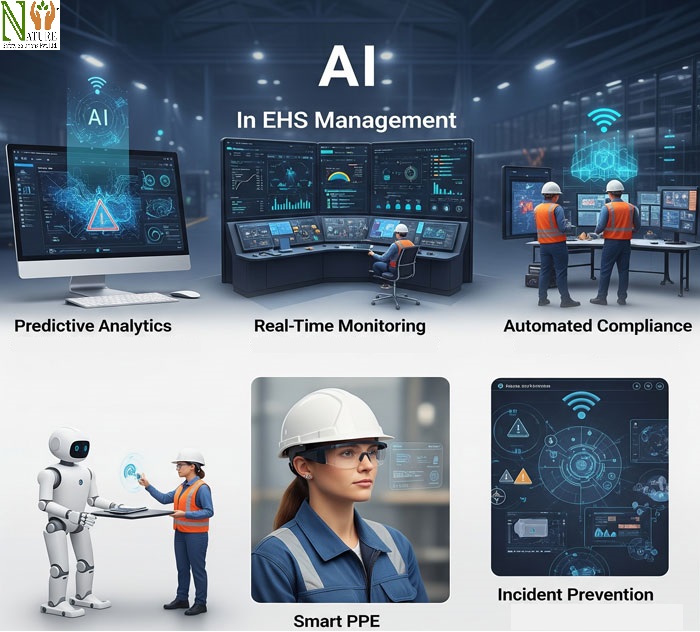Managing Environmental, Health, and Safety (EHS) in today’s fast-paced industries demands more than checklists and manual inspections. As workplaces grow more complex, so do the risks. Companies need to keep up with growing safety and compliance demands. To do this, many are turning to Artificial Intelligence (AI). This powerful technology is quickly changing how we manage safety, compliance, and environmental protection.
Here’s a look at five powerful ways AI is being used to enhance EHS management, making operations safer, smarter, and more efficient.

1. Predictive Analytics: Staying Ahead of the Risk
AI makes it possible to anticipate safety risks before they turn into real incidents. Using predictive analytics, AI systems analyze data from past incidents, maintenance logs, environmental sensors, and human behavior to spot hidden trends.
For example, if AI notices that machine-related injuries often happen after a certain number of hours, it can alert teams in advance. This allows them to schedule maintenance or rotate staff before an accident occurs.
How it helps:
- Prevents accidents before they happen
- Minimizes downtime and disruptions
- Encourages proactive safety planning
2. Computer Vision: Smart Eyes on the Worksite
AI-powered computer vision automates site monitoring. Cameras with AI can detect unsafe actions, spot safety violations, and send real-time alerts to teams. This helps prevent accidents and improves workplace safety.
Whether it’s a worker without a helmet, a blocked emergency exit, or an oil spill on the floor, these systems catch what human eyes might miss—24/7.
How it helps:
- Delivers instant alerts for quick response
- Improves compliance and visibility
- Reduces the burden on human inspectors
3. Environmental Monitoring: Tracking Impact in Real Time
Environmental risks like air pollution, noise, or chemical leaks can be difficult to manage manually. AI-enhanced sensors now offer real-time monitoring of environmental conditions – and AI platforms can analyze that data immediately.
For instance, if emissions exceed safety thresholds, the system can send alerts, adjust operations, or trigger automatic shutoffs.
How it helps:
- Supports compliance with environmental regulations
- Detects issues early to prevent harm
- Helps meet sustainability and ESG goals
4. Natural Language Processing: Smarter Safety Documents
AI can also make sense of complex EHS documentation through Natural Language Processing (NLP). These tools can scan thousands of safety reports, audit findings, or regulatory texts in minutes.
They identify trends, highlight compliance gaps, and even summarize large documents—saving valuable time for EHS professionals.
How it helps:
- Speeds up audits and reporting
- Identifies recurring safety issues
- Makes safety information more accessible
5. Wearable Tech: Real-Time Worker Protection
Smart wearable devices, such as sensor-equipped vests, helmets, and wristbands, track workers’ health and exposure in real time. They monitor vital signs, movement, and environmental conditions. This data gives safety teams instant insights. It helps them detect risks early and respond quickly to protect workers.
They track data such as:
- Heart rate, body temperature, and fatigue
- Hazardous gas exposure or noise levels
- Fall detection or excessive strain
AI then processes this information to detect dangers early and notify supervisors before conditions become critical.
How it helps:
- Prevents health emergencies
- Ensures faster response to incidents
- Builds a culture of care and safety
Also read:
